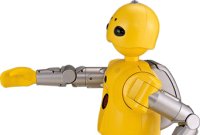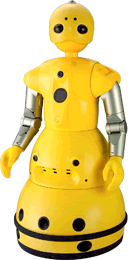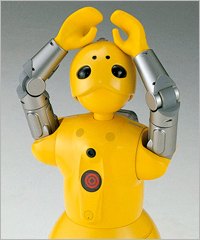Linux-powered humanoid robot on sale Friday
Sep 19, 2005 — by LinuxDevices Staff — from the LinuxDevices Archive — 1 views A run of 100 Linux-powered humanoid robots goes on sale in Japan Friday, priced at 1.5M Yen (about $14,000), not including 10,000 Yen (~$90) monthly service fees. Mitsubishi Heavy Industries conceived of Wakamuru as a pleasant companion offering a range of electronic-age valet services, it says.
A run of 100 Linux-powered humanoid robots goes on sale in Japan Friday, priced at 1.5M Yen (about $14,000), not including 10,000 Yen (~$90) monthly service fees. Mitsubishi Heavy Industries conceived of Wakamuru as a pleasant companion offering a range of electronic-age valet services, it says.

Wakamaru augments speech synthesis with physical gestures
 Mitsubishi first announced Wakamaru in March of 2003, adding details the following month.
Mitsubishi first announced Wakamaru in March of 2003, adding details the following month.
Mitsubishi says it has tried to create a robot that can sustain meaningful relationships with human beings, initiating conversations with family members and offering services such as alarm, news, weather, and email dictation. The device can look after the house, provide video streams over cellular networks, and cull useful information over the Internet, while maintaining its own autonomous “rhythm of life,” the company says.
 According to Mitsubishi, Wakamaru was designed by Mr. Toshiyuki Kita, who patterned the robot after a growing child. The name “wakamaru” derives from the childhood nickname of Minamoto Yoshitsune, a twelfth-century Japanese Samurai who engineered military victories that enabled his brother Yoritomo to gain control of Japan. The name is associated with “growth” and “development,” the company says.
According to Mitsubishi, Wakamaru was designed by Mr. Toshiyuki Kita, who patterned the robot after a growing child. The name “wakamaru” derives from the childhood nickname of Minamoto Yoshitsune, a twelfth-century Japanese Samurai who engineered military victories that enabled his brother Yoritomo to gain control of Japan. The name is associated with “growth” and “development,” the company says.
Wakamaru uses face recognition to identify up to ten people, including two that considers “owners.” It uses speech recognition technology to identify 10,000 Japanese words. Speech synthesis capabilities include voice modulation and using gestures when speaking. It recognizes names given it by users, Mitsubishi says.
 A panoramic top-of-head camera enables Wakamaru to identify its position in the house according to the ceiling. This camera also allows the robot to face others when speaking to them or being spoken to.
A panoramic top-of-head camera enables Wakamaru to identify its position in the house according to the ceiling. This camera also allows the robot to face others when speaking to them or being spoken to.
Wakamaru stands just shy of 4 feet tall (100cm), and weighs 66 pounds (30 kg). It can travel at 1km per hour, avoiding objects and identifying moving people, Mitsubishi says.
Wakamaru's claimed battery life is two hours, after which the robot returns to its charging station before power fails completely. It maintains Internet access and communications capabilities while charging, Mitsubishi says.
Additional interesting details and photos are available on Wakamaru's homepage, here.
This article was originally published on LinuxDevices.com and has been donated to the open source community by QuinStreet Inc. Please visit LinuxToday.com for up-to-date news and articles about Linux and open source.